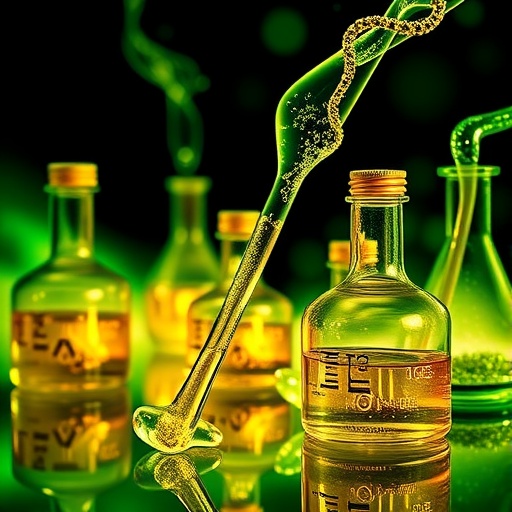In a groundbreaking advancement for sustainable chemical manufacturing, a team of researchers has unveiled a remarkable synergy between gold, manganese, and copper that dramatically enhances the selective oxidation of ethanol to acetaldehyde. This development centers on ingeniously engineered catalysts where ultra-small gold nanoparticles are anchored onto a perovskite oxide framework comprising lanthanum, manganese, and copper (LaMn0.75Cu0.25O3). The results showcase an impressive acetaldehyde yield surpassing 95% at a notably low temperature of 225 °C, exemplifying a significant leap toward greener, more energy-efficient chemical processes.
Acetaldehyde is an imperative intermediate in the production of an array of chemicals, including plastics, pharmaceuticals, and adhesives. Conventionally, acetaldehyde synthesis relies heavily on the Wacker oxidation process, which transforms ethylene but suffers from drawbacks such as high cost, harsh reaction conditions, and environmental concerns involving toxic reagents and excessive energy consumption. Consequently, the catalytic selective oxidation of bioethanol derived from renewable biomass has emerged as a more sustainable alternative pathway worthy of intensive research.
Despite promising efforts over the past decades, catalysts capable of achieving both high activity and selectivity for ethanol oxidation to acetaldehyde under mild conditions have remained elusive. Most catalytic systems exhibit a compromise, either favoring conversion at the expense of selectivity or vice versa, typically yielding less than 90% acetaldehyde. Prior pioneering studies demonstrated the crucial role of specific metal site interactions, especially between gold and copper species, in enhancing catalytic performance, such as the Au/MgCuCr2O4 catalyst achieving over 95% yield at 250 °C with remarkable operating stability.
Building upon this foundation, the collaboration between Huazhong University of Science and Technology and Eindhoven University of Technology introduces an innovative approach by tuning the manganese/copper ratio within the perovskite host lattice. The Au/LaMn0.75Cu0.25O3 catalyst emerges as the optimal formulation, demonstrating superior catalytic efficiency below 250 °C and surpassing the performance benchmarks previously set. This catalyst operates with a synergistic mechanism where the gold nanoparticles and the moderately copper-doped perovskite support engage cooperatively to accelerate ethanol oxidation kinetics.
The catalyst synthesis employed a sophisticated sol-gel combustion technique to generate highly crystalline perovskites with precise control over elemental distribution and morphology. Subsequent deposition of gold nanoparticles ensured uniform dispersion on the oxide surface, facilitating intimate contact between metallic and support phases. Rigorous catalytic testing confirmed that the optimized composition consistently maintained acetaldehyde selectivity at an extraordinary level of 95% with steadfast stability sustained over an extended duration of 80 hours, which represents a significant stride toward industrial applicability.
The intriguing contribution of copper doping is twofold: a catalytic promotion effect arising from the generation of active Cu+ sites near the gold interface and electronic modification of the support that enhances oxygen activation. However, the research also illuminated a delicate balance—the catalytic efficacy declines when the copper content surpasses the optimal threshold, likely due to the destabilization and reduction of Cu+ species under reaction conditions, culminating in diminished active site availability and catalyst deactivation.
To elucidate the atomic-level dynamics behind this advantageous synergy, the team employed advanced computational techniques, including density functional theory (DFT) calculations paired with microkinetic modeling. These simulations revealed that copper substitution into the manganese sites of the perovskite lattice engenders oxygen vacancies and electronic states that lower the activation energy barriers for key reaction steps such as O–H bond dissociation in ethanol and oxygen molecule activation. This synergistic interplay at the metal-support interface rationalizes the experimentally observed performance enhancements.
The comprehensive integration of experimental and theoretical insights underscores the paramount importance of rational catalyst design guided by atomic-scale understanding. Tailoring the composition and electronic environment within perovskite supports emerges as a viable strategy for engineering highly active and selective heterogeneous catalysts for sustainable chemical transformations. This advances not only the fundamental scientific knowledge but also ushers in practical opportunities to replace conventional petrochemical routes with renewable feedstocks under milder, eco-friendly conditions.
Moreover, by catalyzing ethanol oxidation efficiently at lower temperatures, the Au/LaMn0.75Cu0.25O3 catalyst minimizes energy consumption and reduces carbon emissions linked to industrial acetaldehyde production. This resonates with global efforts targeting carbon neutrality and circular economy principles, highlighting the pivotal role of catalysis innovation in addressing climate change and resource sustainability challenges.
Looking ahead, this research paves the way for further exploration of multimetallic perovskite catalysts and fine-tuning of their compositional parameters to unlock tailored activities for a broad range of selective oxidation reactions. The synergy between noble metals and transition metal-doped oxides could be harnessed to design next-generation catalysts for biomass valorization, pharmaceuticals synthesis, and environmentally benign commodity chemical manufacture.
This landmark study, published in the Chinese Journal of Catalysis, not only validates the promise of gold-manganese-copper synergistic interactions but also exemplifies the effective collaboration between experimental catalysis and computational modeling. Such an interdisciplinary approach is essential for accelerating the discovery and optimization of catalysts that meet both performance and sustainability benchmarks required for future industrial chemical processes.
The implications of this breakthrough extend beyond acetaldehyde production, potentially inspiring new catalytic materials for converting renewable feedstocks into high-value chemicals with unparalleled efficiency and selectivity. With increasing governmental and industrial emphasis on green chemistry, innovations like these represent vital steps toward transforming the global chemical industry toward a more sustainable, circular, and economically viable future.
Subject of Research: Selective ethanol oxidation catalyzed by Au/LaMnCuO3 perovskite-based materials.
Article Title: Unveiling the Au-Mn-Cu synergy in Au/LaMnCuO3 catalysts for selective ethanol oxidation.
News Publication Date: 6-Aug-2025.
Web References:
Chinese Journal of Catalysis – Article DOI
Image Credits: Chinese Journal of Catalysis
Keywords
Applied sciences and engineering
Tags: acetaldehyde production methodsadvanced catalyst engineeringbioethanol as renewable sourceeco-friendly chemical processesenergy-efficient chemical processesgold nanoparticles in catalysisgreen chemistry innovationshigh yield acetaldehyde synthesisovercoming catalytic challengesperovskite oxide frameworksselective oxidation of ethanolsustainable chemical manufacturing





